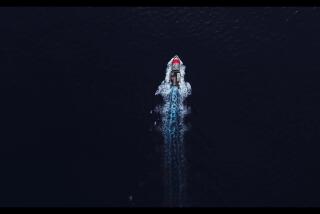Civil War Sub’s Secrets Bared
- Share via
For 136 years, the Confederate submarine H.L. Hunley, the first submersible ship to sink an enemy warship, has sat buried on the floor of Charleston harbor. This week, archeologists will finally remove the last bits of mud and debris that long entombed the ship, revealing to full view one of the most-prized artifacts of the Civil War.
On Feb. 17, 1864, the Hunley sank the Union ship Housatonic, which was blockading the South Carolina port. After displaying a blue lantern to announce the success of its mission, the Hunley also sank for reasons that are not yet clear.
Last year, archeologists raised the ship. Since then, researchers slowly have been digging out the mud that filled the vessel, revealing a treasure house of materials.
The team has removed the bodies of all eight crew members, located a storied $20 gold piece that had saved the captain’s life in an earlier land battle and recovered a large number of artifacts, including canteens, shoes, pencils, a wallet, dog tags, a wrench, iron ballast blocks, the lantern, a compass, a depth gauge, a pair of binoculars and, perhaps, the captain’s logbook.
They also have uncovered a great deal of surprising information about the Hunley’s construction. “This vessel continues to astound everybody with its technological advancement,” said Warren Lasch, chairman of the organization that is sponsoring the excavation, Friends of the Hunley.
“From the first moment we pulled it up, it was surprising how hydrodynamic and sleek it was,” he said. The submarine incorporated many design elements that were not seen again until the German U-boats of World War I. “It was 50 years ahead of its time.”
Legend had it that the Hunley was constructed from two boilers joined together end-to-end, but the excavation has shown that is clearly not the case. Studies of the exterior show that the panels are very carefully assembled to minimize bulges and reduce drag, making it easier for the crew members to propel the vessel.
The crew members sat hunched over on benches--now known to have been coated with lead paint--on both sides of the submarine and operated a crank that extended the length of the vessel. That crank was connected to the propeller shaft by a length of chain. The team was somewhat surprised to find that the crew had a spare chain on board in case the original broke and left them stranded.
More unexpected was the presence of a flywheel on the propeller shaft. The flywheel would have helped keep the propeller spinning at a constant rate and could also have been used in braking.
The steering mechanism brought another surprise, said state senator Glenn McConnell, chairman of the Hunley Commission. Contemporary sketches and reminiscences portrayed the Hunley as having a steering wheel, like surface ships, connected to the rudder via overhead cables through the crew compartment.
What the team actually found was a floor-mounted lever, very much like the joystick on modern airplanes, that was connected to the rudder through cables and rods neatly hidden under the crew benches.
“This could be the world’s first joystick for navigating a vessel,” McConnell said.
Submarine Boasted Sophisticated Design
The joystick’s design was consistent with that of the rest of the vessel, said chief archeologist Maria Jacobsen. “It’s both simple and elegant, representing a design for efficiency and space.”
Archeologists are especially eager to identify the eight crew members. Currently, the only one known for certain is the vessel’s captain, Lt. George E. Dixon.
The seven crewmen who staffed the crank were originally thought to all be relatively young men, in their late teens or early 20s. But examination of the bones revealed that the crew members ranged in age from the mid-40s to a 19-year-old who was apparently operating the bellows that supplied air to the entire ship in the last moments before the Hunley sank.
The team hopes to use the techniques of forensic anthropology to reconstruct each crewman’s face based on the shapes of their skulls.
The team thought it knew what Dixon looked like because they had been given a tintype picture of the captain by the great-granddaughter of his fiancee, Queenie Bennett. But Jonathan Leader, South Carolina State Archeologist, pointed out that the tie, the lapels on the coat, the boots and the furniture in the tintype were all from a post-war period, making it unlikely the picture was taken in 1863 or 1864.
He also noted that officers of the period were invariably photographed in their uniforms and that a young officer as enthusiastic as Lt. Dixon most likely would not have been in civilian clothes for a photograph during the war.
But the team was able to confirm another Dixon legend. According to the story, Queenie Bennett gave Dixon a $20 gold piece when he left Mobile, Ala., for the Battle of Shiloh in 1862. During the battle, the story went, he was struck by a bullet, but it bounced off the gold piece, saving his life. He kept the bent gold piece for good luck.
As Jacobsen was preparing to remove Dixon’s left pelvic bone from the vessel in July, her rubber-clad fingers felt a round shape with ridges along its edges. When it was cleaned, the object proved to be a slightly bent gold piece with the initials G.E.D. engraved on it, along with the inscription “My Life Preserver.”
Another discovery proved more puzzling. Excavating one of the bodies, archeologist Shea McLean found another round object, which proved to be a dog tag. It bore the name of a Union soldier, Ezra Chamberlin of the 7th Connecticut Infantry Regiment, who had been killed the previous July in a failed assault on a Confederate fort outside Charleston.
Artifact May Be Captain’s Log Book
Some have speculated that Chamberlin was a Yankee spy, but the team eventually reached a more prosaic conclusion. One soldier thought to have been a part of the Hunley crew, C.F. Carlson, served in a Confederate artillery unit in the battle where Chamberlin was killed. He may simply have picked up the dog tag as a souvenir.
At least one of the crewmen is likely to be identified because archeologists found an intact wallet near one of the skeletons. They have not yet opened it because it has not been preserved properly.
X-rays of a block of mud removed from under Dixon’s station show a haversack with what might be a logbook in it. The X-rays “show two pieces of metal that could be hinges for a book,” Lasch said. That material will also require further treatment before it is opened, but Lasch remains hopeful that it may contain a listing of the crew.
“We found two pencils, so they must have been writing something,” he said.
Lasch expects that it will take two to three more years of laboratory work to examine all of the artifacts removed from the Hunley.
Meanwhile, now that all the mud has been removed from the vessel’s interior, researchers will begin the process of preserving the Hunley itself. Teams will remove all the concretions of mud and silt on the hull, then carefully dissolve all the salt that has infiltrated the hull over a century and a half. That process is expected to take as long as eight years.
The boat will then take its final resting place in a South Carolina museum especially built for the purpose.
*
Maugh can be contacted at [email protected].
More to Read
Sign up for Essential California
The most important California stories and recommendations in your inbox every morning.
You may occasionally receive promotional content from the Los Angeles Times.










